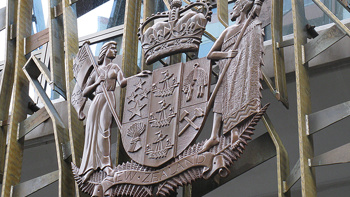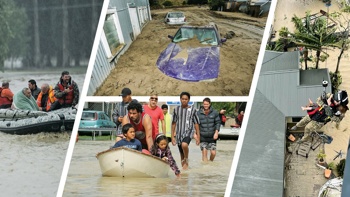UPDATED 9.21PM The army has been called in to clean up Queensland's disaster zone after Cyclone Debbie smashed into the Whitsunday region, unleashing howling winds of 260 km/h.
The storm downed trees, stripped buildings and left shorelines swamped after making landfall as a category four storm at midday near Airlie Beach and is expected to continue wreaking havoc for the rest of the week.
It was downgraded to a category three cyclone just after 3pm but strong winds continued to lash Airlie Beach, Proserpine and Bowen later in the afternoon.
LISTEN: Kimberlee Downs: On the ground in Northern Queensland
The state's premier and police commissioner issued grave warnings to residents.
"We are going to get lots of reports of damage and sadly I think we will also receive more reports of injuries, if not deaths. We need to be prepared for that," Commissioner Ian Stewart said on Tuesday afternoon.
The Insurance Council of Australia declared the storm a "catastrophe", with thousands of claims expected in coming weeks.
It came after a man, believed to be aged in his 60s, was badly injured when a wall collapsed on him in Proserpine.
He is now in a stable condition in Proserpine Hospital.
Premier Annastacia Palaszczuk said the state would be dealing with the impact of the "scary" cyclone for the next three to five days as it moved down the coast.
"I think there is going to be a lot of shock and awe in the morning," she told Ten News.
The pace of the storm - which forecasters say is slower than the likes of Cyclone Yasi and Larry - means recovery efforts won't start in earnest until Wednesday morning.
The Australian Defence Force is mobilising soldiers, vehicles, aircraft and other resources to respond to Debbie, which the Insurance Council of Australia has already declared a "catastrophe".
Queensland Fire and Emergency Services Deputy Commissioner Mark Roche urged residents to watch out for severe flash flooding.
Debbie had been bearing down on the coast since early on Tuesday morning, moving as slow as 4 km/h at some stages.
Proserpine-based Whitsundays councillor John Collins said the initial winds sounded "like a jumbo jet is parked on my roof".
"I've been through a few cyclones that are quick and nasty but this one is going to go all day," he told AAP.
"This is going to be a terrible disaster when it is all over and done with."
There are serious concerns for the region's 2017 sugar cane crop which is estimated at $1.1 billion.
At Bowen, Whitsundays councillor Mike Brunker said "terrifying" winds were battering his home on a hill overlooking Rose Bay.
"It's hitting the southern end of my house and is just shaking the s*** out of it," he told AAP.
"My back fence is laying in the neighbour's yard. It got flogged both ways."
The storm earlier pounded the Whitsunday Islands, with gusts of 263 km/h recorded at Hamilton Island while the jetty at Daydream Island appeared to have washed away.
More than 48,000 homes were without power across the Bowen, Mackay and Whitsunday regions and more than 400 schools and childcare centres closed.
LISTEN: The Whitsundays and Mackay MP Jason Costigan speaks to Jack Tame
Forecasters are also warning people to remain vigilant about damaging deluges following the cyclone, with significant rain expected down the coast towards the state's southeast.
An incredible during and before Tropical #CycloneDebbie photo on Hamilton Island by Daniel McMahon. Latest warnings: https://t.co/XXU3GaE9mf pic.twitter.com/Xa7QdKjx44
— ABC Emergency (@ABCemergency) March 27, 2017
The cyclone's destructive core had been affecting the Whitsundays since 7am, as those in mainland coastal communities awaited her full force.
#CycloneDebbie over the Coral Sea, thanks to @Space_Station | Live blog: https://t.co/mrOSTaBudq pic.twitter.com/GSToRbtpvi
— ABC News (@abcnews) March 28, 2017
Vulnerable residents have been warned the danger will not be over for many, many hours, and they may have to remain in their shelter until Wednesday.
#CycloneDebbie #satellite loop coinciding with wind visualisation from https://t.co/nR8nKDmOxE. Satellite images: https://t.co/l3kCoJ1bPD pic.twitter.com/6UF4G5Ngxo
— BOM Queensland (@BOM_Qld) March 27, 2017
The helplessness felt by Whitsunday Mayor Andrew Wilcox was evident on Tuesday morning, as he monitored damage reports as they started flowing in.
"She's slowed down out there so she can just keep smashing us," he said.
"What would be ideal is for her to either, one, go away, but if not come straight across quite quickly. But, yeah, Debbie isn't playing the game here."
Whitsunday councillor Jan Clifford has spent the morning watching trees take flight from her backyard at Airlie Beach.
"A huge tree in my backyard has been uprooted and has taken out our fence," Ms Clifford told AAP.
"That was a rainforest tree pushing a metre in diameter. It should have been okay. Another tree has landed on my roof. The wind is so loud."
Earlier Deputy Police Commissioner Stephan Gollschewski said roofs were lifting in the Whitsundays region, and some police facilities there had been damaged.
Police commissioner Stewart said Debbie's slow pace is having "a battering ram effect".
"These winds are going to keep pounding, pounding, pounding," he said, and also warned of two possible storm surges coinciding with Tuesday's high tides. Those storm surges have put low lying areas, including in Mackay, at risk of inundation.
It's now pretty wild in #Mackay. #tcdebbie @ABCNewsBrisbane @ABCemergency pic.twitter.com/VORgrXZ5OA
— Melissa Maddison (@meljmaddison) March 27, 2017
4:10 am. Vigorous rainband blasting through #Bowen. #Cyclone #DEBBIE pic.twitter.com/zzsIWz9FVq
— Josh Morgerman (@iCyclone) March 27, 2017
AUSTRALIA'S MOST LETHAL RECENT CYCLONES
* INGRID - March 2005
- Caused widespread damage in both the Northern Territory and Western Australia and then caused the death of five people in PNG after large swells capsized their boat. Ingrid made landfall at Queensland's Cape York as a category 4 before intensifying into Cat.5 as it hit the Top End and then later crossing the Kimberley coastline
* LARRY - March 2006
- Cyclone Larry formed off the far north Queensland coast and intensified to hit near Innisfail as a category 4/5 system. The clean-up bill was around $1.5 billion, wiping out the local banana industry and damaging 10,000 homes, totally destroying 500
* MONICA - April 2006
- Cyclone Monica, a category 5, intensified in the Gulf of Carpentaria and fortunately crossed Cape York in a remote spot, avoiding townships. The damage bill was estimated at least $6 million, which including the loss of a weather station which was completely wiped out
* GEORGE - March 2007
* Cyclone George formed in the Top End and hit the Northern Territory and Western Australia with great intensity, causing three fatalities and numerous injuries around Port Headland. One thousand people in mining camps were left stranded and $6 million worth of damage was done
* YASI - Jan-Feb 2011
- Formed in the Pacific Islands, Yasi was a category 5 as it bore down on Mission Beach, south of Cairns. It wiped out almost a billion dollars worth of crops and agriculture, as well as countless yachts at Port Hinchinbrook. Yasi indirectly caused the death of a man asphyxiated by fumes while sheltering inside with his generator
* MARCIA - Feb 2015
- Forming near Papua New Guinea, Marcia quickly intensified from a category 2 to 5 just before crossing the Queensland coast at the Shoalwater Bay military training area. The remote headland took some of the sting out of the 300km/h cyclone before it still did $90 million-plus damage to Yeppoon and Rockhampton.
Take your Radio, Podcasts and Music with you









